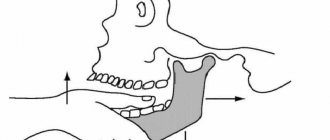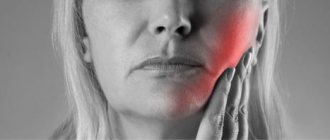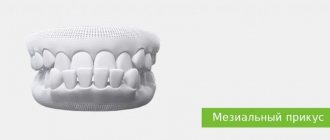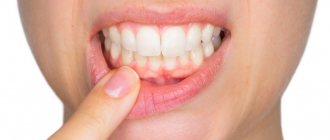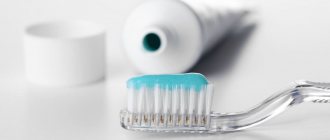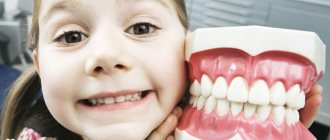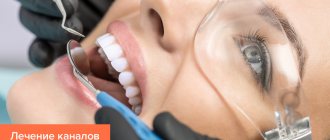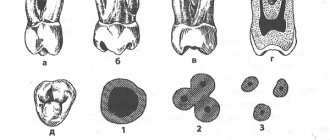Progeny is a deviation from the norm in the structure of the dentition. It is expressed in enlargement and protrusion of the lower jaw. Such pathological deformation occurs statistically in the range of 1.4 - 30% of patients.
External signs:
In addition to a protruding lower jaw, patients with pathology experience:
- recession of the face in the middle part;
- thickening of the lower lip relative to the upper, its protrusion, and sometimes inversion;
- deepened nasolabial folds;
- increased angle between the lower and upper jaw.
Why is progeny dangerous?
With progenia, the process of chewing, digesting and assimilation of food is disrupted. A person with a severe pathology experiences difficulty while eating, sometimes even cannot take a full bite, which leads to increased stress on the gastrointestinal tract.
There is a redistribution of the load on the teeth, as a result of which some of them wear out faster and require frequent treatment. In addition, the proportions are disrupted and the appearance of the face changes. Such an aesthetic defect in childhood can cause complexes and isolation in a child.
Impairments in oral breathing also appear. The consequence of this is an increased incidence of colds, periodic chapping of the lips and dryness of the oral mucosa.
Methods for treating mesial occlusion
Aligners are one of the most practical, convenient, safe and effective correction methods. They are made from polymer materials according to the patient’s individual impression. Therefore, the risk of the structure shifting is completely eliminated. Aligners follow the anatomical shape of the teeth and jaw. They cannot be seen on the teeth due to the complete transparency of the trays. Patients observe minor defects within 2-3 days after installation. They do not interfere with chewing, drinking, or brushing your teeth. You should remove your aligners before performing oral hygiene and eating.
Sign up for free 3D modeling of your future smile!
Make an appointment
*By making an appointment you consent to the processing of your data
Advantages of aligners:
- do not stain;
- not visible to others;
- soft and elastic;
- safe for health;
One of the most advanced foreign bite alignment systems is Invisalign. This is an innovative product from an American company that is used in our clinic. Therapeutic mouth guards create pressure on the teeth, causing them to return to their normal position. We use only original products and are completely confident in the effectiveness of orthodontic treatment with aligners.
During the initial examination, the doctor assesses the condition of the patient’s oral cavity, diagnoses the condition of the jaw system, draws up a treatment plan and names its cost. Before the treatment plan is approved, the patient is shown what the oral cavity will look like after treatment. After agreeing on the details and signing the contract, the doctor performs sanitation of the oral cavity, if there is an indication for this. Therapeutic mouth guards take 2 weeks to make. The elements will have to be changed and will have to be changed every 2-3 weeks. The average duration of treatment with aligners is 6 months to 1.5 years.
Classification of progeny
Pathology is divided into false and true.
In cases of true progeny, the lower jaw develops to a greater extent. In patients with this type, diction is impaired and all external signs of pathology are present. The appearance is influenced by genetic factors, birth injuries and diseases of the woman during pregnancy. It is important to begin treatment at an early age, while the maxillofacial bones can be corrected. Corrective measures are limited to delaying the development of the lower jaw, using massage, and sometimes surgical intervention. In adulthood, adjustments are more difficult. You will need surgery and wearing an orthodontic device.
False progeny is characterized by normal jaw size. In this case, the lower one is shifted forward. Such a bite is formed when a person has to push it forward, as a result of which the muscles and ligamentous apparatus develop incorrectly. The causes are prematurely lost or removed milk teeth in the upper jaw, delayed replacement of teeth, or constant fixation of the lower facial region in the wrong position.
Causes
What are the causes of such malocclusions and are they only the lot of the elderly? In fact, progeny can begin to develop at any age; pregnant women are especially susceptible to it due to taking certain medications. Also reasons are:
- genetic pathologies;
- injuries;
- congenital cleft palate;
- dental abnormalities;
- loss of teeth for various reasons;
- pathology of the alveolar processes.
Correction of bite during progenia
The choice of correction methods depends on the type of pathology and the causes of its occurrence. The orthodontic appliances used stimulate the development of the upper jaw and correct the position of the teeth. DaVinci studio dentists use:
- mouthguards;
- trainers;
- plates.
These are less painful and long-lasting methods of correction. When starting treatment in adulthood, the braces system will help you achieve the desired result. Children wear them from one to one and a half years, while adults wear them for about four years.
Serious dental deformities in the absence of a desire to use braces are treated with surgical intervention in adulthood. Surgery is a financially expensive method associated with the risk of complications. Therefore, if a dentist recommends wearing orthodontic appliances, it is better to listen to the advice.
Methods for correcting mesial occlusion in adults
Mesial occlusion, which is detected before the age of 12 years, is more treatable. Unfortunately, this does not always happen and often adult patients seek help in correcting their bite. Conservative orthopedic methods for correcting occlusion are sometimes ineffective. Often teenagers and adults complain of pain and discomfort when installing a corrective structure. But at the PROPRICUS clinic they use the most effective methods. Serious defects can be corrected with veneers, aligners, and mouth guards. We treat mesial occlusion in adults even in the most difficult situations, when it seems that it is impossible to return the teeth to their normal appearance.
Prevention
If the pathology is not congenital, the formation of a pathological bite can be avoided by taking timely measures:
- Plan your first visit to the dentist when the child is 2-3 years old;
- stop smoking and drinking alcohol (even in small doses) while planning pregnancy and while carrying a baby;
- prevent the development of bad habits: wean your baby off thumb sucking, get rid of pacifiers and bottles in a timely manner;
- From early childhood, teach to keep your posture straight, since the interconnection of all systems in the body has been proven. Slouching changes the tilt of the head, which contributes to the constant advancement of the lower jaw forward;
- Monitor the position of the child's head during sleep. The child should not get used to placing a pillow or fist under it. Excessive pressure on the jaw creates an incorrect bite. You should also avoid throwing your head back or pressing your head to your chest.
The main signs of progeny are a signal for immediate contact with the dentist. Pay special attention to your child, because it is in childhood that pathology is easy to correct.
Add a comment
Leave your comment
Main symptoms
The main symptoms of progeny are the following:
- the lower jaw protrudes strongly forward;
- the facial oval is distorted, its shape is stretched;
- the lower lip may protrude forward and overlap the upper lip;
- the chin becomes too pointed;
- there is no natural fold between the chin and lower lip, instead a bulge forms;
- nasolabial folds become pronounced, asymmetries and indentations appear in the maxillofacial area.
All this is accompanied by disturbances in chewing function, the development of too large front teeth, and a lisp of speech.
Article:
Preventive examinations reveal various dental anomalies in modern preschool children; they affect from 60 to 80% of children.
The frequency of children's speech disorders also fluctuates in the same range. During preventive examinations, various “predilections” of babies are revealed: sucking a pacifier, putting something in the mouth, biting lips or cheeks, breathing through an open mouth, sticking out the tongue, licking the mouth, and so on. Seemingly innocent pranks! Should we fight them? Psychologists are mostly categorical: “No!” Speech therapists will object and say that it is these habits that lead to both dental anomalies and defects in sound pronunciation. Dentists will support them. They know very well that normally a three-year-old child should have a correct primary bite: smooth jaw arches, the upper and lower teeth “look” at each other, and the upper incisors overlap the lower ones by 1/3 when the jaws are closed. If you have bad habits, none of this happens, because the bite is either open (front or side), or cross, or progeny (the lower jaw protrudes forward), or prognathia (the upper teeth hang over the lower lip). Speech therapists will also add: at the same age (three years), all the basic sounds should appear in the baby’s speech, and the vocabulary should reach a thousand words, but with the above malocclusions, this is impossible to achieve, either theoretically or practically; therefore, the child will have a speech delay development.
How to eliminate progeny?
Correcting progeny (the lower jaw protrudes unnaturally forward) can be difficult. But regularly wearing a vestibular plate (with the visor pointing upward) and performing articulation exercises (myogymnastics) help cope with this malocclusion.
The child needs to imagine that his teeth and lips are “stubborn doors” that always strive to “skew.”
1. Articulation exercise “Aligning the doors”: a) open your mouth slightly, then, slowly moving the lower jaw back, place the edges of the lower central teeth on the edges of the upper ones, hold this position for 5-10 seconds;
b) open your mouth, then, moving the lower jaw back, compress your lips tightly, slightly biting them with your teeth, hold for 5-10 seconds.
What should you do if one door leaf prevents the other from closing? That's right, take a plane and remove all the “unnecessary”!
2. Exercise “Plane”: “Cross” the upper central teeth along the lower lip at least 10-15 times. The lower jaw moves back and actively “helps” in this work.
3. Exercise “Rabbit”: a) bite the lower lip with your upper front teeth at least 10-15 times. Then grab your lower lip with your upper teeth and hold this position for 5-10 seconds. The upper front teeth are clearly visible during this exercise.
b) try to reach the upper part of the chin with your upper incisors and also lightly bite it. Fix this low position of the upper jaw on the chin and hold it for 5-10 seconds. The upper front teeth are clearly visible.
And now he will play hide and seek with his lips and teeth.
4. Exercise “Hide and Seek”: “hide” the lower lip behind the upper front teeth and the upper lip, biting it. In this case, only the upper lip is visible, it seems to hang over the chin, but the upper teeth are not visible. Hold in this position for at least 5 seconds (the time increases from session to session.
With the help of articulation exercises and plates, the child acquires useful skills that help him cope with the pronunciation of difficult sounds, and he develops a correct bite. But you have to be prepared for the fact that wearing the plates and producing sounds will last for several years. This will require enormous patience from parents and children.
Correction techniques
Elimination of the defect involves drawing up a treatment plan based on the root causes of its occurrence. Methodologies used include:
- Prevention of bad habits leading to malocclusion;
- Massage therapy applied to the alveolar ridge;
- Corrective plastic surgery of shortened frenulum;
- Installation of vestibular plates;
- Prescribing a set of exercises in combination with labial activators;
- Grinding of dentition elements to restore occlusion;
- Use of a Brückle apparatus, protracting springs or occlusal pads;
- Hardware treatment that restores the functionality of the jaw.
For patients in the older age group, as a rule, more radical methods are recommended, including the installation of orthodontic structures and braces, as well as surgical intervention.
An incorrect bite will cause gum and soft tissue diseases, and also contribute to the formation of mechanical injuries. Over time, thinning of bone tissue and aesthetic problems caused by hypertrophy of individual elements of the dentition will come. Uneven load leads to deterioration of the periodontal condition and complicates oral hygiene, so at the first signs of pathology it is recommended to consult a dentist.
Complications without treatment
In case of malocclusion, treatment is always necessary, since the pathology is not only accompanied by cosmetic defects, but can also cause various complications, which include:
- improper chewing load leads to rapid wear of tooth enamel, which causes increased sensitivity and the risk of premature loss;
- development of periodontal disease against the background of increased periodontal wear;
- problems with the digestive system due to poorly chewed food;
- underdevelopment of individual facial muscles and the appearance of painful sensations in them;
- premature tooth loss;
- difficulties associated with treatment - prosthetics and implantation.
Also, with an abnormal bite, problems with diction, jaw joints, and the rapid occurrence of infections in the oral cavity may occur. With timely and proper treatment, such complications can be completely eliminated.
